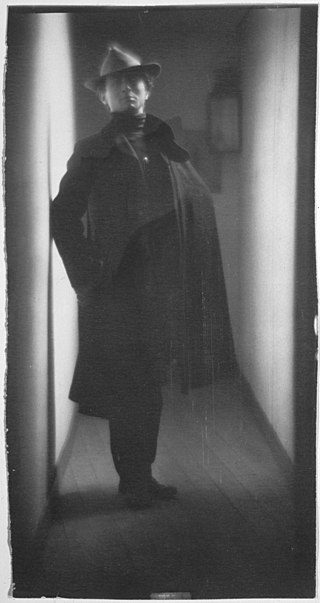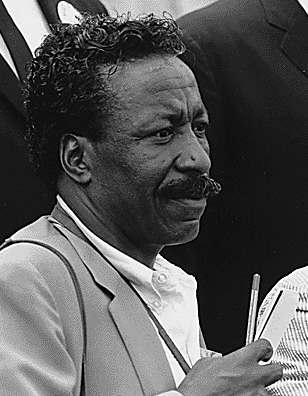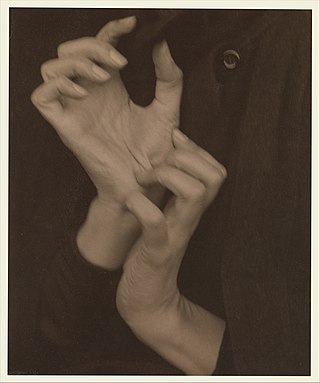Related Research Articles

Gloria May Josephine Swanson was an American actress. She first achieved fame acting in dozens of silent films in the 1920s and was nominated three times for the Academy Award for Best Actress, most famously for her 1950 return in Billy Wilder's Sunset Boulevard, which also earned her a Golden Globe Award.

Edward Jean Steichen was a Luxembourgish American photographer, painter, and curator, renowned as one of the most prolific and influential figures in the history of photography.

Gordon Roger Alexander Buchanan Parks was an American photographer, composer, author, poet, and film director, who became prominent in U.S. documentary photojournalism in the 1940s through 1970s—particularly in issues of civil rights, poverty and African Americans—and in glamour photography. He is best remembered for his iconic photos of poor Americans during the 1940s, for his photographic essays for Life magazine, and as the director of the films Shaft, Shaft's Big Score and the semiautobiographical The Learning Tree.

Richard Avedon was an American fashion and portrait photographer. He worked for Harper's Bazaar, Vogue and Elle specializing in capturing movement in still pictures of fashion, theater and dance. An obituary published in The New York Times said that "his fashion and portrait photographs helped define America's image of style, beauty and culture for the last half-century".

The Family of Man was an ambitious exhibition of 503 photographs from 68 countries curated by Edward Steichen, the director of the New York City Museum of Modern Art's (MoMA) department of photography. According to Steichen, the exhibition represented the "culmination of his career". The title was taken from a line in a Carl Sandburg poem.

Fashion photography is a genre of photography that portrays clothing and other fashion items. This sometimes includes haute couture garments. It typically consists of a fashion photographer taking pictures of a dressed model in a photographic studio or an outside setting. It originated from the clothing and fashion industries, and while some fashion photography has been elevated as art, it is still primarily used commercially for clothing, perfumes and beauty products.

Lois Wilson was an American actress who worked during the silent film era. She also directed two short films and was a scenario writer.

Seena Owen was an American silent film actress and screenwriter.
The Hallmark Photographic Collection was amassed by Hallmark Cards, Inc. and donated to the Nelson-Atkins Museum of Art in Kansas City, Missouri in December 2005. At the time of donation, the collection consisted of 6,500 images by 900 artists, with an estimated value of $65 million.
Robert Hanley "Bob" Willoughby was an American photographer. Popular Photography called him "The man who virtually invented the photojournalistic motion picture still."

Todd Webb was an American photographer notable for documenting everyday life and architecture in cities such as New York City, Paris as well as from the American west. He traveled extensively during his long life and had important friendships with artists such as Berenice Abbott, Walker Evans, Alfred Stieglitz, Georgia O'Keeffe, Ansel Adams, Dorothea Lange, and Harry Callahan.
Nell (Becker) Dorr was an American photographer.
Joan Cassis was an American photographer known for her black and white portraiture work. She often colored black and white photos with oil paints, blending photography and painting.
Lisa Larsen (1925-1959) was a pioneering woman photojournalist.

Georgia O'Keeffe - Hands, also known as Georgia O'Keeffe (Hands), is a black and white photograph taken by Alfred Stieglitz in 1919. It is part of a large group of more than 300 photographs that he took of the painter Georgia O'Keeffe, from 1917 prior to their 1924 marriage, through 1937.

The Family, Luzzara, Italy is a black and white photograph by Paul Strand, taken in 1953. It was made during a five monts staying in Luzzara, in the Po River Valley, north Italy, the birthplace of his friend, screenwriter Cesare Zavattini, which was documented in the book Un Paese (1955), illustrated with his photographs and Zavattini's text. Strand's group of photographs depicts the hardships and conditions of the rural Italy at the time, and is directly related to the neorealism esthetic, of which Zavattini was an exponent in cinema.
The Pastry Cook, also known as The Pastry Chef, is a black and white photograph taken by German photographer August Sander, in 1928. It was included in his photography book Face of Our Time, published in 1929, and was part of his project People of the 20th Century. The current photograph became one of the most famous in his depictions of professions and characters of the Weimar Republic.

Balzac, the Open Sky is a black and white photograph taken by American photographer Edward Steichen in 1908. The photograph is part of a series created by Steichen that depict the statue of Honoré de Balzac by Auguste Rodin, executed in plaster, in 1898. The statue would eventually be cast in bronze and inaugurated in Paris, in 1939.
Two Shells, also known as Shells, is a black and white photograph taken by American photographer Edward Weston, in 1927. It was part of a series containing 26 photographs of sea shells from the same year, including Weston's famous Nautilus.

In Memoriam is a black-and-white photograph by American photographer Edward Steichen, from 1904. It is one of his best-known pictorialist works and is a nude portrayal of a deceased female model, hence its title.
References
- 1 2 "Edward Steichen - Photographs". Phillips. New York. April 8, 2018. Retrieved 2022-12-10.
- ↑ Richard H. Saunders, American Faces: A Cultural History of Portraiture and Identity, University Press of New England, 2016, p. 82
- ↑ Richard Brilliant, Portraiture, Reaktion Books, 2013, p. 153
- ↑ "Metropolitan Museum of Art". metmuseum.org. Retrieved 2022-12-10.
- ↑ "Edward Steichen. Gloria Swanson, New York. 1924". MoMA. Retrieved 2022-12-10.
- ↑ "Gloria Swanson | Amon Carter Museum of American Art". cartermuseum.org. Retrieved 2022-12-10.
- ↑ "Gloria Swanson – Works – The Nelson-Atkins Museum of Art". art.nelson-atkins.org. Retrieved 2022-12-10.